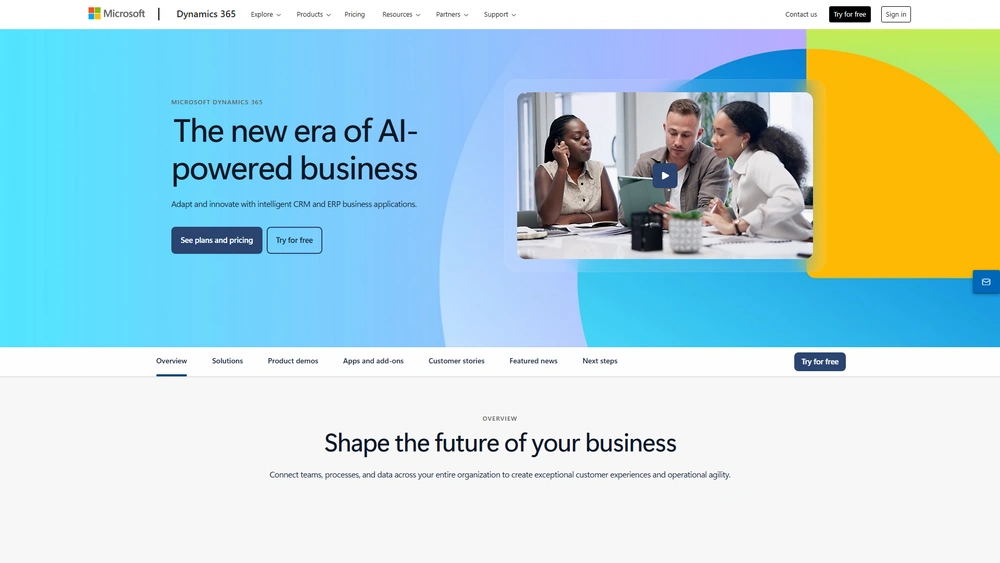Microsoft Dynamics 365 Business Central Overview & 2025 Industry Position
Microsoft Dynamics 365 Business Central is Microsoft’s all-in-one business management solution specifically tailored to small and midsize enterprises (SMEs). As part of the Dynamics 365 suite, it provides a comprehensive set of tools that span finance, supply chain, sales, project management, and customer service. In 2025, Microsoft Dynamics 365 Business Central is positioned as the go-to ERP choice for modern SMBs seeking flexible cloud operations, native Office integration, and AI-powered efficiency.
Its deep links with the Microsoft ecosystem—Power BI, Teams, Outlook, and Microsoft 365—make it uniquely attractive for businesses already invested in MS infrastructure. With AI-assisted forecasting, seamless workflows, and a continuously growing marketplace of pre-built integrations, it meets the growing demand for digitization, automation, and scalability in today’s operational landscape.
From Launch to 2025: Microsoft Dynamics 365 Business Central’s Journey
Originally launched in 2018 as Microsoft’s cloud-centric evolution of Dynamics NAV, Business Central aimed to bring ERP power to small and midsize businesses. Early adoption surged due to inclusion in Microsoft’s Dynamics 365 ecosystem, leveraging the familiar UI and cloud-first approach.
- 2018: Official launch of Business Central on the Dynamics 365 platform.
- 2020: Integration with Microsoft Teams and rapid enhancements to mobile experiences.
- 2021: Expansion of APIs and connector availability via Microsoft AppSource.
- 2023: Copilot AI integration introduced for forecasting, workflow suggestions, and real-time insights.
- 2024: Vast localization upgrades supporting compliance across emerging markets.
- 2025: Strategy refocuses on growing partner ecosystem and embedded AI to drive predictive operations.
For 2025, Business Central’s strategic focus is on accelerating AI adoption for SMBs, via Copilot-enhanced automation and predictive capabilities linked tightly to finance, supply chain, and forecasting modules.

Key Features of Microsoft Dynamics 365 Business Central
Microsoft Dynamics 365 Business Central delivers key functionalities across core business areas with an intuitive interface and intelligent workflows. Notable features include:
- Financial Management: General ledger, bank reconciliation, budgeting, and fixed assets, enhanced by AI-driven forecasts.
- Sales & Service: Quote-to-cash automation, multi-channel sales tracking, and integrated communications via Outlook and Teams.
- Supply Chain: Inventory, purchasing, and warehouse management with demand planning support.
- Project Accounting: Resource management, job costing, and timesheet tracking.
- AI-Powered Copilots: Contextual assistance, data insights, and task automation embedded directly into workflows.
- Global Compliance & Localization: Country-specific tax logic, currency support, and regulatory adaptability.
Workflow & UX Simplicity
Business Central’s user interface is familiar for anyone who’s used Microsoft 365. It borrows heavily from Outlook and Excel’s logic, making onboarding smoother with minimal training.
Key UX elements include:
- Personalized role centers per department or job function
- Drag-and-drop UI panels for dashboards and tiles
- Real-time search across records, transactions, and reports
- In-app Copilot tooltips suggesting next-best actions
Whether accessed via browser or mobile app, Business Central’s design centers on speed and worker familiarity—ensuring that processes feel seamless from day one.
Microsoft Dynamics 365 Business Central Pricing Analysis & Value Metrics
Business Central pricing as of July 2025 is transparent and modular, making it easier to scale as organizations grow:
| Plan | Price (User/Month) | Includes |
|---|---|---|
| Essentials | $70 | Core finance, sales, purchasing, inventory, and project management |
| Premium | $100 | Everything in Essentials + service management and manufacturing |
| Team Members | $8 | Read and limited write access for light users |
Value Assessment: Pricing lands on the affordable side for full-feature ERP systems. With deep Microsoft integration and fast deployment, TCO remains markedly lower than SAP or Oracle options.
Competitive Landscape
Business Central occupies a mid-market sweet spot. Here’s how it stacks up against alternatives:
| Platform | Best For | Base Price | Key Differentiator |
|---|---|---|---|
| NetSuite | Medium-large enterprise | $99/user/mo | Strong global financial consolidation |
| Sage Intacct | Finance-first teams | $80/user/mo | Core strength in multi-entity accounting |
| Microsoft Dynamics 365 Business Central | Growing SMBs | $70/user/mo | Excel/Outlook-native UX + Copilot workflows |
Pro Tip: If your team already uses Microsoft 365, onboarding to Business Central takes a fraction of the time compared to other ERPs.
Business Central Use Cases & Industry Relevance
- E-commerce: Real-time inventory sync, multi-channel order tracking, and automated invoicing.
- Professional Services: Project-based billing, time tracking, and resource planning.
- Wholesale & Distribution: Demand forecasting, warehouse control, and streamlined procurement.
- Nonprofits: Grant management, compliance reports, and donor/customer data sync.
Integrations & Ecosystem
Few ERPs match Business Central’s depth of out-of-the-box integrations across:
- Microsoft Stack: Office 365, Teams, Azure, Power Platform
- Payments & eCommerce: Shopify, PayPal, Stripe, Square
- CRM & Marketing: Dynamics 365 Sales, HubSpot, Mailchimp
- Payroll & HR: ADP, Gusto, QuickBooks Time
AppSource enables fast access to hundreds of vetted third-party apps, most deployable without coding.
Pros & Cons
- Pros:
- Tightly integrated with Microsoft 365
- Affordable, scalable pricing tiers
- Strong AI Copilot capabilities
- Worldwide compliance & localization
- Cons:
- Steep learning curve for ERP newcomers
- Premium plans unlock key features
- Customization options require technical support
Final Thoughts on Business Central
Microsoft Dynamics 365 Business Central is powerful, accessible, and increasingly intelligent—a near-ideal ERP platform for SMBs in 2025. Its value compounds for businesses already using Microsoft tools, and its AI-first trajectory ensures relevance for years ahead. Ideal for scaling teams that want flexibility, financial rigor, and a familiar interface wrapped in a single platform.
Microsoft Dynamics 365 Business Central FAQ
Yes. It includes modules for sales, project management, service, and even light HR functions beyond core accounting.
No. Business Central is cloud-native and requires internet for most operations, although cached data may be visible.
Most SMBs can launch within 4–12 weeks, depending on data import, integrations, and training needs.
Yes. Business Central handles multi-currency, multi-entity setups with country-specific legal and tax logic.
Standard support is included. Premium support plans are available through Microsoft partners for 24/7 access and dedicated success managers.